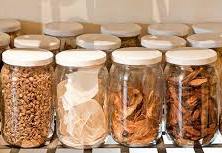 Proponents of herbal medicine also known as alternative medicine are rooting for adoption of herbal formulations in managing and curing livestock diseases arguing that they are cheaper and readily available than the conventional ones.
Proponents of herbal medicine also known as alternative medicine are rooting for adoption of herbal formulations in managing and curing livestock diseases arguing that they are cheaper and readily available than the conventional ones.
One man has been an avid crusader and has successfully developed formulations for the treatment of East Coast Fever, New Castle, Rabies, and ecto parasites, diseases considered among the most stubborn by scientists. Dr. Jack Githae a herbalist and veterinarian says that livestock farmers must be given the freedom to choose what best suits their needs and addresses their concern. He is of the opinion that the low livestock deaths during past years were largely due to the potency of traditional medicine.
"Herbal formulations are cheaper than convectional one since they are available in Kenya and other African countries," said Dr Githae who is also the Director of School of Alternative Medicine and Technology (SAMTECH).
The World Health Organisation (WHO) reports that in Africa over 80 per cent of the population depends on traditional medicine for primary care. Most of the livestock diseases are always cured using herbs that have been identified through a slow process of learning for millennia.
According to the organisation, herbal medicine is worth about Sh500 billion globally. This represents 20 per cent of the global overall drug market. Over a 30 year period, Dr Githae has developed 36 patentable herbal formulations to treat diseases. Of these, 12 formulations are for treatment of livestock disease.
For ECF, a disease found in eastern and southern Africa, herbal formulations to fully cure an animal costs t between Sh500- 1000. Conventional medicine costs over Sh4000 a dose. "With herbal medicine, the farmer will continue to consume milk and meat products. On the contrary, when a cow is being administered with convectional drugs, no milk is consumed for over four days and it takes a month for meat to be safe," adds Dr Githae.
The herbalist has also worked for Food and Agricultural Organisation and the United Nations Development Programme as a sheep production officer. Dr Githae is a member of WHO's expert committee on traditional medicine. He has previously held consultative positions with international medical and veterinary bodies. Drenching sheep and goats against tapeworms and liver flukes costs between Sh20-30. Convectional dewormers cost over Sh200 per dose and have to be changed regularly to avoid resistance. Most of the herbal formulations are administered orally though mastitis has intramammary injectables.
"For this sub-sector to be fully developed, herbal medicine practitioners must be recognised, subsidised, professionally and legally protected," says Dr Githae. He says that international drug manufacturers are wary of herbal practitioners believing that they might affect the sales of convectional drugs in the continent. Equally, governments in the continent have been slow in recognising the important role of herbal practitioners in providing health care services for humans and livestock.
Githae says herbal formulations must also be integrated with other drugs to make them available in chemists and other drugs outlets. He gives examples of India and China -two countries that long ago recognised and developed herbal medicine. In the two countries, medical practitioners prescribe convectional drugs and herbal formulations.
The two countries also earn billions of shillings from exports of herbal formulations. Among the plant species that have successfully used to manage livestock and human disease include the Neem tree, Aloe vera and African berries.
















Comments powered by CComment